The Baltic Sea
If you decide to visit all the countries in the world, you’ll end up in places that might not have been on your bucket list. No worries! This will give you the chance to get to know places that should have been on your bucket list because they’re magical, charming and/or friendly. This is how I feel about the five countries — plus one autonomous archipelago — that surround the Baltic Sea.
For this two-week adventure, I followed the route shown on the map here. August is an excellent time of year to visit these places, with sunny days and long, cool evenings. Tourist sites are all open, yet they aren’t crowded.
Although I’d planned to use my Eurail pass to do much of this travel, I ended up on buses for the overland routes. I took buses because the railway lines in Estonia, Latvia and Lithuania don’t connect with the rest of Europe. Why? Because they were built by Russia. The Soviet railway network (shown in red on the map to the left) was designed to carry people and products to and from Moscow — and nowhere else. Also, Russia uses a 1520mm (5ft) gauge, instead of the standard 1435mm (4.7ft) gauge of Europe, China, the Middle East and the US. As a result, European trains can’t travel to Russia, and vice versa. This railway incompatibility may be one reason why the Baltics don’t have as many tourists as the rest of Europe. This will all change in 2026 when the Baltic countries are connected to the rest of Europe via Rail Baltica.
In spite of limited rail service, surface transport in the Baltics is fast, clean, convenient and inexpensive. Baltic buses have free wifi and in-seat entertainment systems. The ferries across the Baltic Sea are smooth and spacious. The trains in Finland are luxurious — even in 2nd class. I loved arriving at the station or the dock at the last minute and not having to bother with airport security. Also I had none of the headaches I’d had in July with flight cancellations due to weather or strikes. In case you’d like to book your next Baltic adventure, here are some of the companies that I used:
With five buses, four ships and two trains, my two weeks through the Baltics was one of the most relaxing trips I’ve made in a long time. Everywhere I went there were wonderful things to see, great food to eat, and friendly people to meet. There are also no more Covid restrictions, so travel is fun and easy again. If you haven’t been to the Baltic countries, go now! … before everyone else discovers these treasures hidden in Eastern Europe.
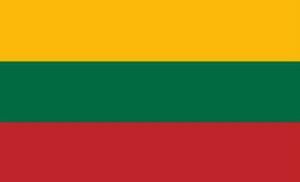
The first stop on my journey was Vilnius, the capital of Lithuania. I came here by bus from Warsaw. As I rolled through the forests of eastern Poland into Lithuania, I studied my Lonely Planet guide to learn about a country (the size of West Virginia) that I knew absolutely nothing about.
Vilnius is a mix of old and new. The old city has palaces and castles whose foundations were laid in the XIII century. A long line of kings and dukes held off invaders from the East and West until this land eventually became a duchy of Poland.
During World War II, the city was alternately overrun by Germany and Russia. By 1945, Vilnius was a pile of rubble. Today, the city has been meticulously restored. The Palace of the Grand Dukes is a museum which records eight centuries of Lithuania’s struggles to be an independent nation.
I spent most of my time in the old city, with its gothic cathedrals, flower shops and cafés on every street. Shall I mention that prices for food and housing are 30% lower here than in western Europe?
And did you know that 44 million years ago, a vast coniferous forest grew in this part of Europe? The resin from this forest fossilized and generated more than 100,000 tons of amber, with the result that today the Baltic countries are the source of 90% of the world’s amber. Vilnius together with the neighboring Russian oblast of Kaliningrad are two of the best places to buy it. Although amber isn’t a precious stone, its warm colors and soft texture make it a favored natural material to make jewelry with. Vilnius’s jewelry shops like free gem museums.
What I’ll remember most about Vilnius was relearning World War II and Cold War history. History comes alive when you learn it where it happens and it’s told by people who were affected by it.
On August 23, 1939, Stalin and Hitler agreed to a non-aggression pact that included a secret deal to divide Europe into Nazi and Soviet “spheres of influence.” With this division, Germany claimed western Poland and part of Lithuania. The Soviet Union would occupy eastern Poland, the Baltic states and Finland. One week later, Germany invaded Poland. Two weeks later, the Soviet Union attacked Poland from the east. This is how World War II began.
In 1941, Germany reniged on the non-aggression agreement by invading Russia. Russia retaliated by joining the Allies and fighting back, all the way to Berlin. After the war, Russia decided to keep the Baltic states and several other countries, all of which ended up behind the Iron Curtain as part of the Soviet Union.
For decades, Lithuania, Latvia and Estonia suffered and chafed under occupation by totalitarian governments. Then, on August 23, 1989 (the 50th anniversary of the Stalin-Hitler pact), the people of Lithuanian, Latvia and Estonia did something rather remarkable. Two million people joined hands across three countries to form a human chain spanning 690 km (430 miles) to demand their freedom from Russia. This political event is known as the Baltic Way. The Guinness Book of Records lists the Baltic Way as the longest human chain ever created.
This human chain helped publicize the Baltic cause around the world. Seven months after this protest, Lithuania became the first Soviet republic to declare independence. Ten other nations followed Lithuania’s steps, leading to the breakup of the Soviet Union. Why didn’t I know this bit of history until now? Because from 1989 through the early 1990s, I was so busy raising two young children that I didn’t have time to read newspapers or watch the news. Now I know — and so do you!
If you’re reading this blog today, please take a moment to consider the bravery and the unity of Lithuania, Latvia and Estonia. In this world of strife and turmoil, this is an uplifting story of people working together to make the world a better place to live and to be free. Yesterday, various commemorative initiatives were held in the Baltics to celebrate the 33rd anniversary of this historic event.
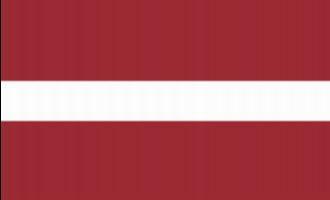
An easy 4½ bus ride took me from Vilnius to Riga, the capital of Latvia. This city gets my nomination as one of the world’s most photogenic cities. Everywhere I looked were beautiful buildings and evocative architecture. Naturally, all these buildings are beautifully restored after being razed by Russia during World War II.
In the center of Riga’s old city is the House of the Blackheads. Have you ever heard of St.Maurice? Until I came to Riga, neither had I. Maurice was an Egyptian commander in the Roman army in the 3rd century. As a Christian, he and his legion were martyred for refusing to worship Roman gods or to kill Christians. In the XIV century, St.Maurice became the patron saint of a guild of merchants, shipowners and foreigners in Riga. This guild named themselves The Brotherhood of the Blackheads because St.Maurice was Black.
During the Middle Ages, the Blackheads became successful and powerful. Their stunning meeting hall is the most recognizable building in Riga. The interior of the House of the Blackheads is like a palace. Today, it’s used for official events and as a museum. In the plaza outside, I enjoyed a cello concert one evening. Click here to hear this talented cellist play.
The plaza in front of the House of Blackheads claims to be the place where the first decorated Christmas tree stood. There’s a small monument to commemorate a December night in 1510 when the guild masters erected an evergreen tree, covered it with roses, danced around it and then set fire to it. This started the Christmas tradition that we all observe today.
Riga is full of outdoor cafes and restaurants, popular in summer. I enjoyed a few evenings at these sociable venues It was easy to chat with locals and tourists about travel and politics. Yes, there are lots of tourists in the old city, but not so many that it’s a crush of people every day.
As I wandered through the old city, my camera was busy all the time. During the Middle Ages, Riga was a walled city. Here’s one of the old gates.
The Cathedral of Riga is the largest medieval church in the Baltic states, and the oldest built in 1211. Evening concerts on the organ — with its 6718 pipes — are inspiring.
In addition to fortified walls around the city, Riga was originally surrounded by a moat. Today, the moat and the greenway beside it is a delightful park. The moat has become a canal through which luxurious skiffs cruise back and forth.
Just beyond Riga’s canal is a newer part of the city, created during a building boom in the early 1900’s. The fashion trend of the time was Art Deco. Several prominent architects competed to produce some of Riga’s most elaborate and attractive buildings. The photos below come from a neighborhood of several square blocks. I visited this amazing neighborhood twice just to take photos in different lighting. Here are some of my favorites. Click any photo to zoom in.

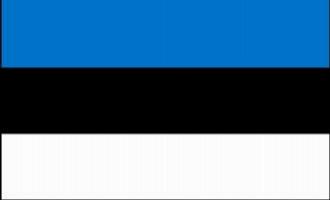
Another bus ride took me from Riga to Talllin, the capital of Estaonia. What makes this city unique is that its old city is totally medieval.
Walking around the old city feels like being in a time warp. The defensive walls, the watch towers, the town hall, the cathedral and the store facings are all restored to what they looked like eight centuries ago.
Many of the city walls are intact. As you pass in and out of the old city, you walk through medieval gates decorated with coats of arms.
Inside the city walls, cobblestone streets are filled with cafés and restaurants. Summer is the ideal time for dining al fresco. I doubt there’s much outdoor dining in January.
Tallinn’s old city is centered around a grand plaza flanked by XIII century shops, offices, pubs and eateries — all beautifully restored, of course. Another great place to meet people to discuss travel and politics!
None of the Baltic states have much affection for Russia. The USSR occupied and exploited Estonia, Latvia and Lithuania for more than 50 years. The memory of those dark times is still fresh. During my visit to Tallinn, the Russian embassy, which is a posh building in the middle of town, was shuttered, with the sidewalk outside choked with signs protesting the war in Ukraine. A problem facing the Baltic states these days is that during the Soviet occupation, many Russians were forcibly relocated here. Today Russians represent a sizeable minority within each country. Deporting these people back to Russia is not possible. So, the Baltic states worry that Mr.Putin may decide to invade in order to “protect” the Russian-speaking people who live here.
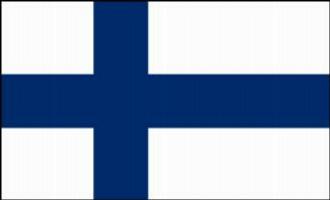
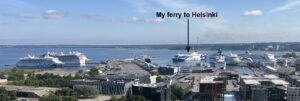
From Estonia, my next stop was Finland. In peacetime, I might’ve taken a bus to St.Petersburg to tour its famous cathedrals, palaces and museums. From there, I could have continued overland to Helsinki. Instead, the closure of the Russian border gave me an excuse to take a ferry across the Gulf of Finland and to discover how to travel in luxury for just a few euros.
Until now, I’d never looked closely at a map of Finland. This is a country that lends itself well to travel by water because Finland is surrounded by thousands of islands. Cruising into Helsinki’s harbor through a maze of emerald isles is a very scenic way to arrive in this city.
On my approach to Helsinki, I passed the Suomenlinnan Islands, which is home to a Lutheran church with a tall spire. Most churches have tall spires, but this one is unique. At the top of the spire is a light for nighttime navigation. I’m told that this is the only church-lighthouse in the world. How practical!
Here’s the harbor of Helsinki, with both the old and the new, the cathedral and the giant wheel.
Another curiosity in Helsinki’s harbor is the Submarine Veskko. This is the only remaining Finnish submarine from World War II. It was built in 1933 for the Finnish navy. Although it managed to sink only one enemy ship, it was the first ship sunk in the Baltic Sea by a submarine. Yay!
I crossed Finland to get to the port of Turku, Finland’s oldest city. This was my first train ride since Italy. I was again impressed by how beautiful, clean, fast and modern these European trains are. Why can’t America have good train service? It’s complicated, but I think we know the answer to that question.
Although I wasn’t able to spend much time in Finland, I managed to mingle a little bit. I was impressed by the Finnish enthusiasm for health and fitness, and amused by one particular outdoor exercise program. Check out these bouncy shoes! Click here to watch them in action.
In Finland, there was one place I stayed overnight that was especially noteworthy. On the west coast of Finland in the port of Turku, there’s a retired cruise ship that’s been converted into a youth hostel. I had a private cable with a porthole plus breakfast the next morning for just €54. If you’re ever in Turku, you must stay here.
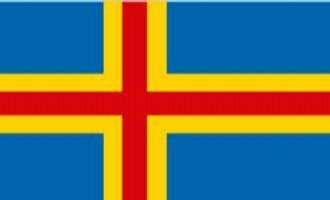
From Turku, I borded another ferry. Here’s the gorgeous ferry that’s part of the Tallink / Silja Line. Although the main function for this ferry is to transport cars and trucks between Finland’s many island, there were a few walk-on passengers like me. Actually, I think there were only about 200 passengers. For a ship this size, it allowed us all to have a lot of room to spread out in and relax.
I love ship travel. The ferries to and from Finland were especially fun and easy. On boarding this ferry, I was greeted by a polar bear, the mascot of the ferry line. Now why doesn’t United Airlines greet its passengers with an adorable mascot? By the way, these ferry crossings were cheap. About $20 per crossing for a passenger without a vehicle.
The ferry brought me to a group of islands halfway between Finland and Sweden known as the Åland Islands. This is an autonomous part of Finland which was originally part of Sweden. The League of Nations granted these islands to Finland in 1922. What’s odd about this place is that the official language is Swedish, even though this is part of Finland. A century ago, the Ålanders voted 95% in favor of being part of Sweden, but the League of Nations made them part of Finland. The Ålanders I spoke with explained politely there must’ve been some “politics” involved.
Located in the middle of the Baltic Sea, these islands are strategically and commercially important. Over the past few centuries, the Åland Islands became a major shipping hub with hundreds of tall ships sailing in and out of here. Here’s the home of one of the shipping barons who lived here.
Today, the population of the Åland Islands is about 30,000. Its capital and main city is called Mariehamn. It’s a quiet little burg with cobblestone streets and café and shops. The middle of the town is adorned with a beautiful tree-lined boulevard that has about as many pedestrians as it has cars. A quiet, quaint place with lots of fresh air, this would be a good place to come for a few months to write a book.

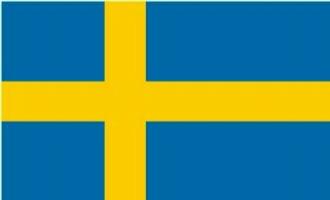
The final leg of my European odyssey involved one last ride on a ferry from the Åland Islands to Stockholm. Again, I looked at a map and realized that these waters are full of islands. While the Åland Islands are more than 6000, Sweden has another 270.000 islands of its own. Wow!
Many of the islands are inhabited. What a lovely place to live in the summer. I’m not sure how nice these places are in winter though. Brrr!
In any case, this is a sailor’s paradise.
How were all these islands formed? This region was buried under glaciers during the last Ice Age. While moving glaciers carved an uneven rolling surface just below sea level, the weight of the ice pushed the granite down below sea level. Then, when the ice melted 12,000 years ago, the granite knobs rose back up, creating lots of little islands from Finland to Norway.
The best — and only — way to see all these beautiful little islands is by boat. The ferries that go back and forth are perfect for the viewing
Sweden was my last stop on this journey. I was here for a day to catch a flight back to the USA. This has been a great adventure, especially on water.
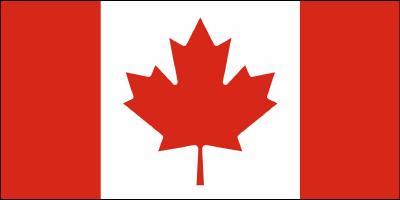
So, when’s my next boat trip? It starts tonight! I’m back in the US, heading north for my nautical adventure. Here’s what the ship looks like. Stay tuned for more.
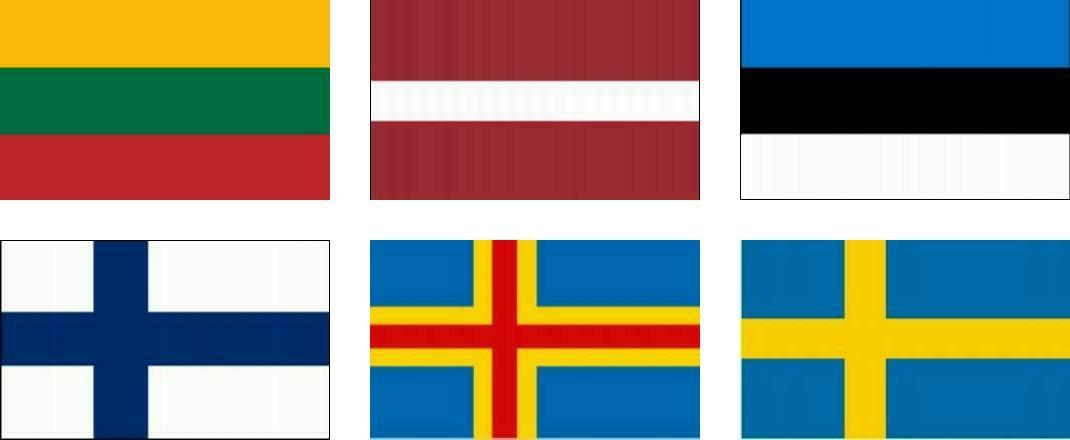
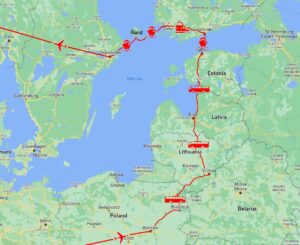
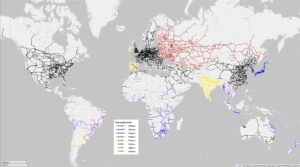
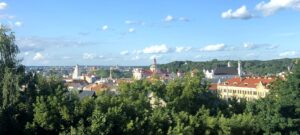
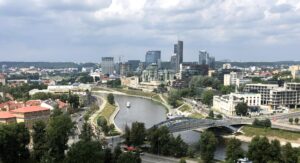
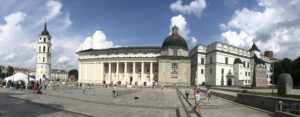
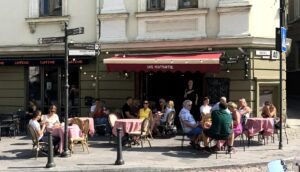
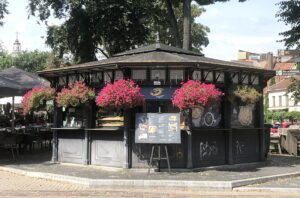
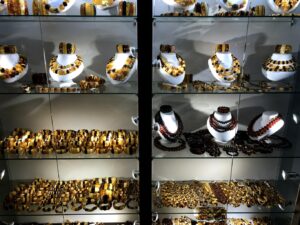
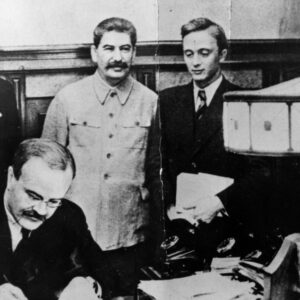
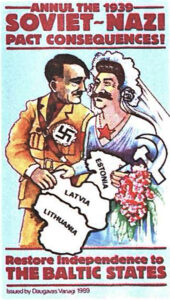
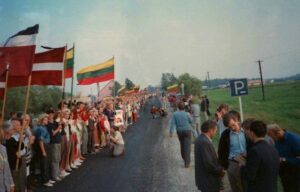

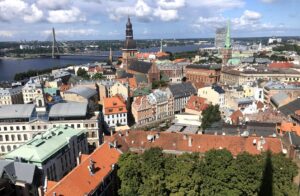
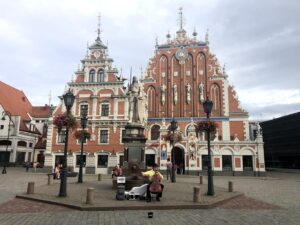
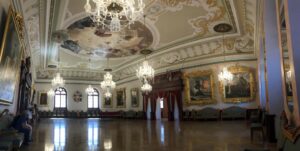

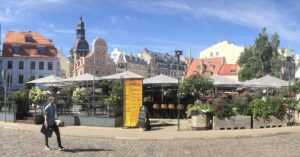
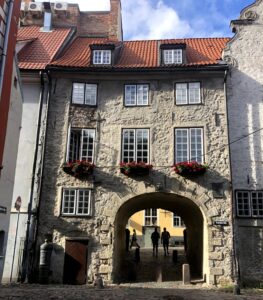
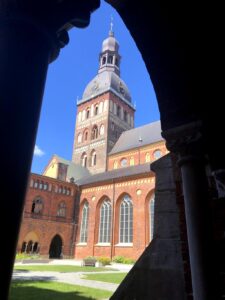
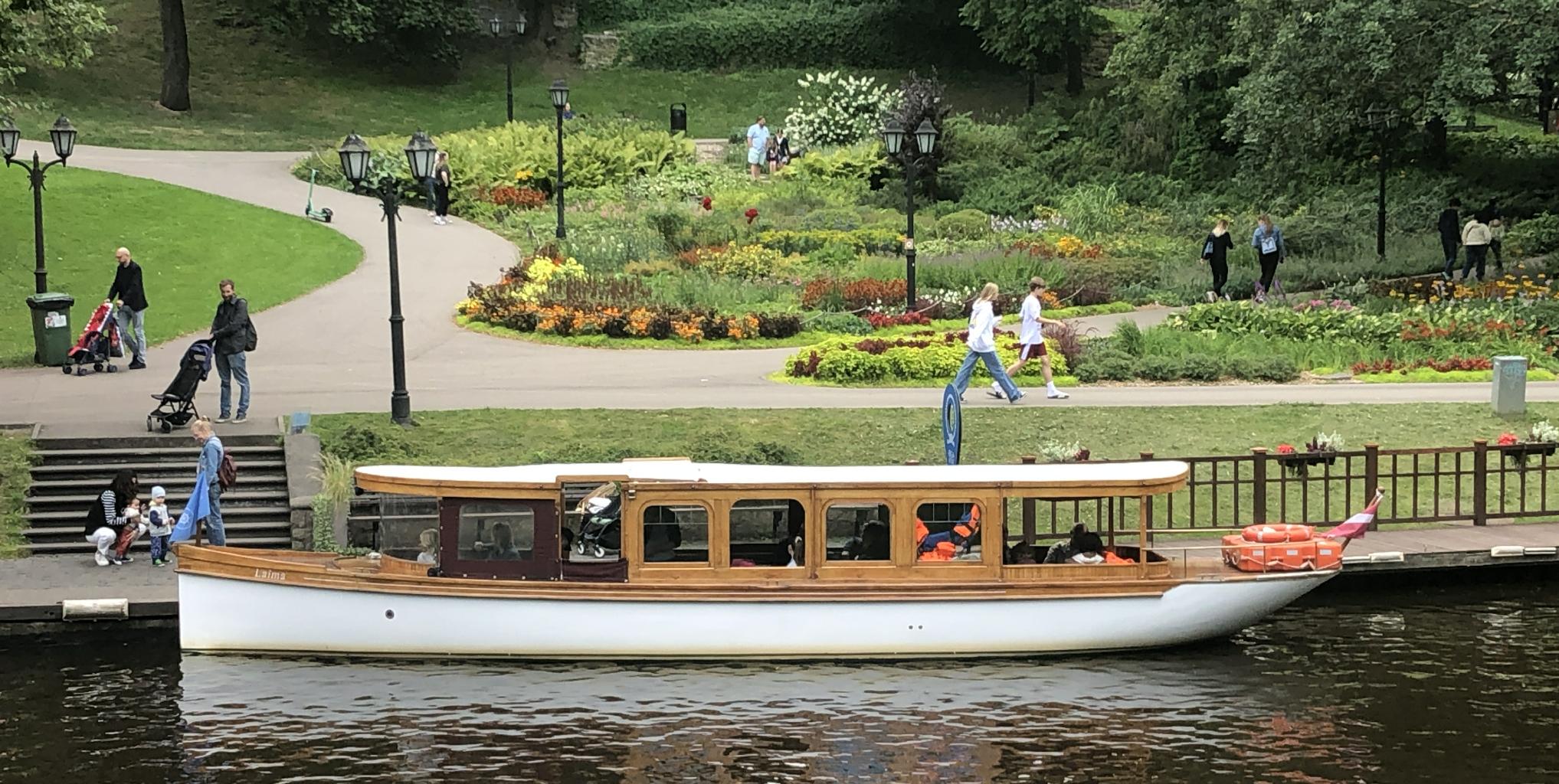
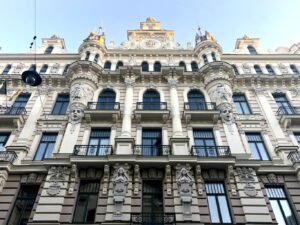
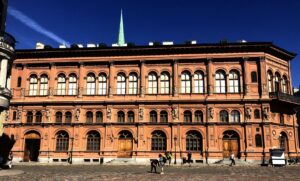
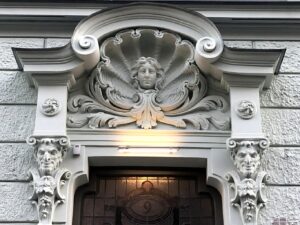
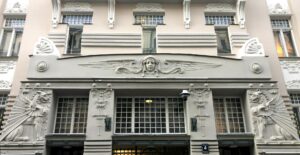
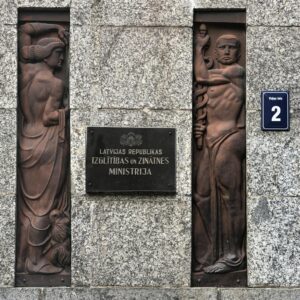
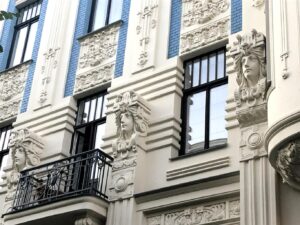
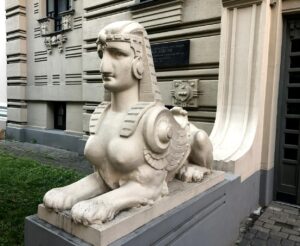
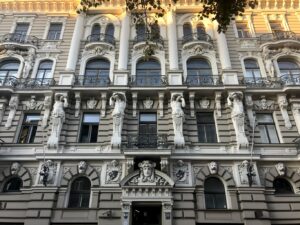
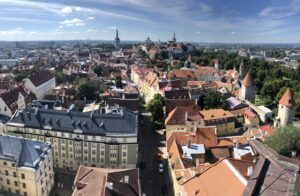
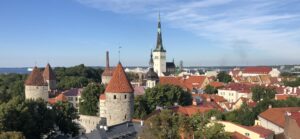
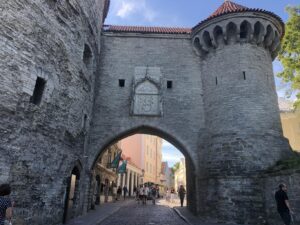

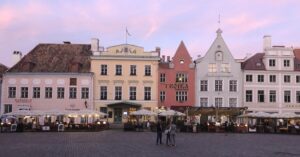
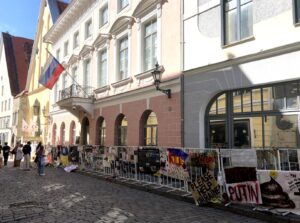
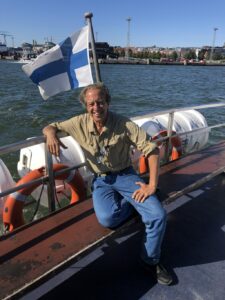
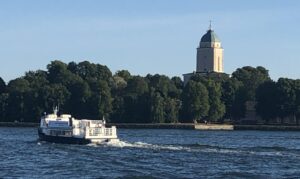
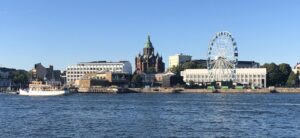
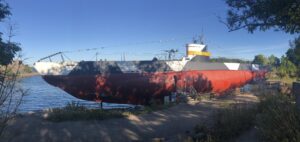
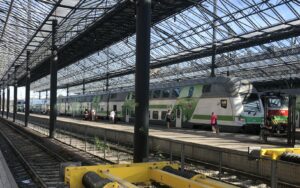
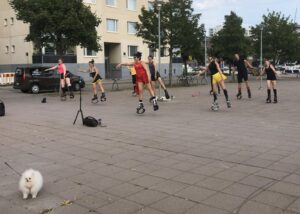
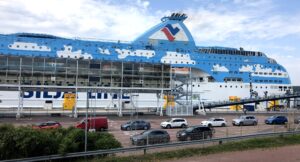
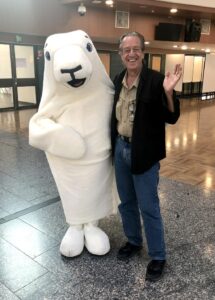
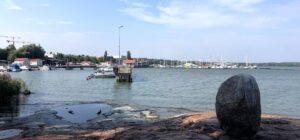
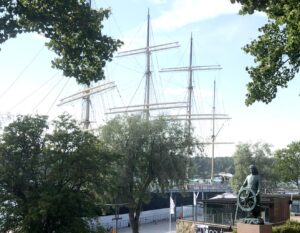
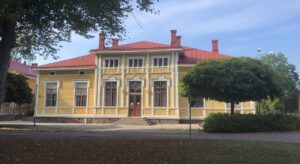
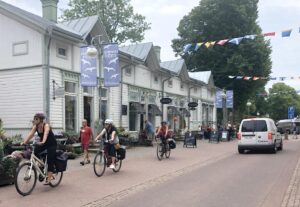
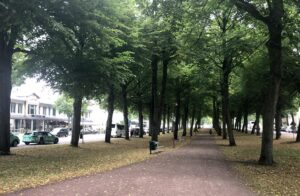

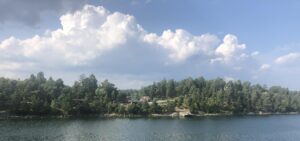
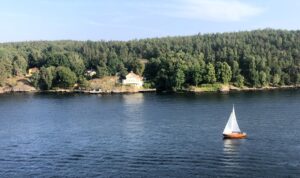
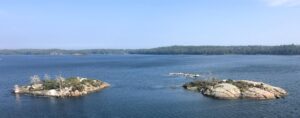
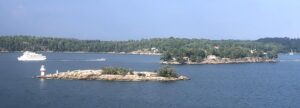
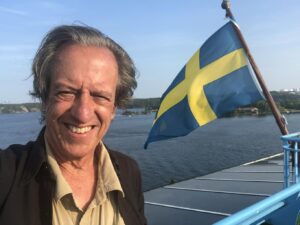
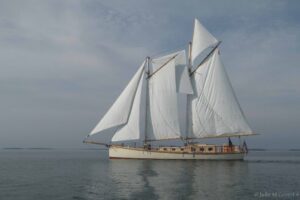
There are several Ingmar Bergman films set on the islands around Sweden. Maybe you’ve seen them? One is called “Hour of the Wolf.” I think I read that Bergman and Liv Ullman actually did live on an island for a while.
It’s kind of poignant and amazing that people rebuilt their devastated cities after World War II. I wonder if some of the funding for that came from the Marshall Plan.
Hi Nick, enjoyed your tour of the Baltics! Timely, too, as I just booked a trip to Finland. Flying Tbilisi to Helsinki early November and taking the train to Rovaniemi, where I hope to see the Aurora Borealis and an online friend for the first time in person. You’ve given me a lot of addition travel plans for the region. Thanks! Take care, travel well.
The Aurora are a glorious natural display. Before you go to Rovaniemi, be sure to get the My Aurora Forecast & Alerts app. This will tell you which hour you’re most likely to see aurora and in what location.
Thank you for the detailed report on the Baltics and Finland. They’re definitely on my list!
Looked like a wonderful, beautiful trip Nick! Liked your great descriptions of all the sights!
Suzi